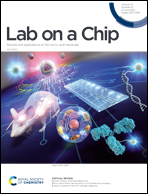Non-small cell lung carcinoma spheroid models in agarose microwells for drug response studies
Abstract
There is a growing interest in developing personalized treatment strategies for each cancer patient, especially those with non-small cell lung carcinoma (NSCLC) which annually accounts for the majority of cancer related deaths in the US. Yet identifying the optimal NSCLC treatment strategy for each cancer patient is critical due to a multitude of mutations, some of which develop following initial therapy and can result in drug resistance. A key difficulty in developing personalized therapies in NSCLC is the lack of clinically relevant assay systems that are suitable to evaluate drug sensitivity using a minuscule amount of patient-derived material available following biopsies. Herein we leverage 3D printing to demonstrate a platform based on miniature microwells in agarose to culture cancer cell spheroids. The agarose wells were shaped by 3D printing molds with 1000 microwells with a U-shaped bottom. Three NSCLC cell lines (HCC4006, H1975 and A549) were used to demonstrate size uniformity, spheroid viability, biomarker expressions and drug response in 3D agarose microwells. Results show that our approach yielded spheroids of uniform size (coefficient of variation <22%) and high viability (>83% after 1 week-culture). Studies using epidermal growth factor receptor (EGFR) tyrosine kinase inhibitor (TKIs) drugs gefitinib and osimertinib showed clinically relevant responses. Based on the physical features, cell phenotypes, and responses to therapy of our spheroid models, we conclude that our platform is suitable for in vitro culture and drug evaluation, especially in cases when tumor sample is limited.



 Please wait while we load your content...
Please wait while we load your content...